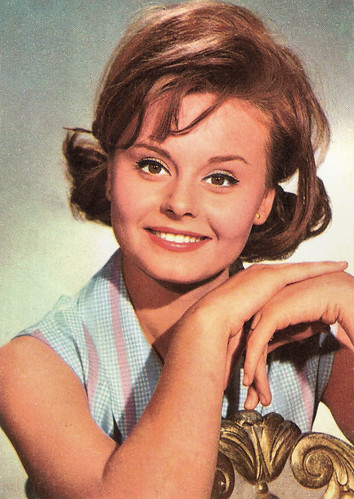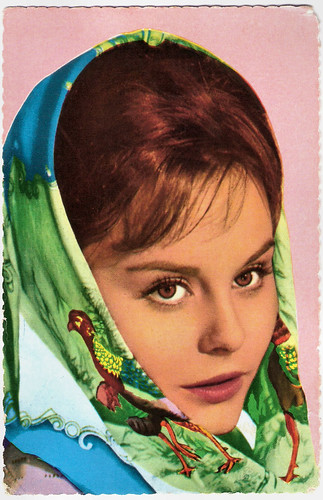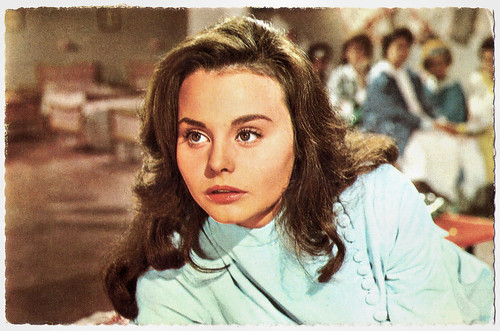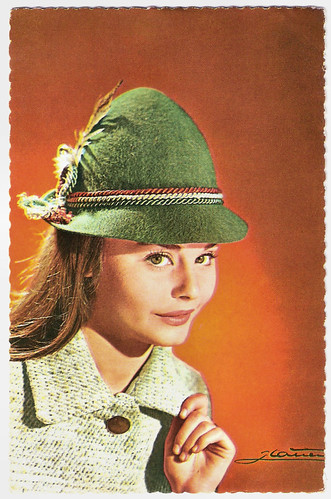Spanish singer and actress Rocío Dúrcal (1944–2006) was called the 'Queen of Ranchera', the traditional Mexican song. She began in the 1950s as a child star and as a teenager, she appeared in a series of popular Spanish 1960s musicals. Later she focused on her musical career, became a star in Mexico and Latin America and won several Latin Grammy awards for her albums with rancheras and ballads.

Spanish postcard by Ediciones Tarjefher, no. 214. Photo: Epoca Films.

Spanish postcard by Ediciones Tarjefher / Ediciones Mandolina, no. 212. Photo: Epoca Films.
Rocío Dúrcal was born María de los Ángeles de las Heras Ortiz in Madrid, Spain, in 1944. She was born and raised in Spain in the bosom of a working-class family. At the age of 10, ‘Marietta’ took part in the radio show, 'Conozca a sus Vecinos' (Meet Your Neighbours). In these shows, she charmed the audience with her clear and melodic voice which also made her a winner in many other radio contests that she participated in those years. She was secretly supported by her paternal grandfather, who believed in her talent and was her first fan.
In 1959, with the approval of her parents, she participated in the television program Primer Aplauso (First Applause). For the contest, she sang the traditional song 'La sombra vendo'. Manager Luis Sanz was impressed by her talent and personality and signed her up. Soon after, she started taking singing and dancing lessons with Lola de Aragón and Alberto Lorca. From that time, Maria began working as Rocío Durcal. Durcal is taken from a town in the province of Andalucia in southern Spain.
Her new name was used for the first time in her debut film, the musical Canción de Juventud/Song of Youth (Luis Lucia, 1961). The film was a huge box office hit in Spain and in other Spanish-speaking countries. Soon followed another film vehicle, Rocío de La Mancha (Luis Lucia, 1963) and a record deal with Phonogram (now Universal Music). Many other young singer-actors in Spanish films were popular at this time, including Raphael, Marisol, and the twin sisters Pili and Mili.
The songs Dúrcal performed in her films served to make her debut album, 'Las películas de Rocío Dúrcal' (The films of Rocío Dúrcal, 1962). It was the start of a successful recording career. Durcal travelled to Mexico, Venezuela, Puerto Rico and the United States where she appeared on The Ed Sullivan Show. In her fourth film, Tengo 17 años/I am 17 (José María Forqué, 1964), Dúrcal abandoned the role of a child star. That same year, she made her stage debut in 'Un domingo en Nueva York' (A Sunday in New York), in which she proved to be a good theatrical actress. In 1965 she filmed Más bonita que ninguna/Prettier than any (Luis César Amadori, 1965) for which the pop group Los Brincos (considered at the time as the Spanish version of The Beatles) wrote some songs.
In 1966, she shared the spotlight with Enrique Guzmán in the film Acompáñame/Accompany Me (Luis César Amadori, 1966). She began to perform duets with such singers as Jaime Morey and Amalia de Isaura. Then she co-starred in the film Amor en el Aire/Love in Flight (Luis César Amadori, 1967) with Argentine singer-songwriter Palito Ortega and Fernando Rey. The following year, she filmed Cristina Guzmán (Luis César Amadori, 1968), the first of her films that was aimed at an adult audience. She plays the double role of a young widow with a child, who is asked to replace a missing woman, and of course, also plays the missing woman who suddenly returns.

Spanish postcard by Ediciones Tarjefher, no. 206. Photo: Epoca Films / Foto Guzman.
In 1970, Rocío Dúrcal married Philippine musician Antonio Morales, better known as Júnior, a former member of Los Brincos. He would later manage her singing career. In 1972, Morales began a series of television shows in Spain and Latin America singing with his wife as a duo. Their first child, Spanish actress Carmen Morales de las Heras, was born in 1970. After the birth of their second child, Antonio Morales de las Heras, in 1974, Morales decided to give up his career to devote time to their children. In 1979 they had their third child, Shaila Morales de las Heras, who is now also a singer under the stage name of Shaila Dúrcal.
Dúrcal continued her film and singing career. During the 1970s she appeared in such films as the musical La novicia rebelled/The Rebellious Novice (Luis Lucia, 1971) and the French-Spanish thriller Dites-le avec des fleurs/Say it with Flowers (Pierre Grimblat,1974), starring Delphine Seyrig. Her final film was the drama Me siento extraña/I Feel Strange (Enrique Martí Maqueda, 1977).
In 1977, Dúrcal signed a contract with Ariola Eurodisc, and from then on dedicated herself to her musical career. That year, while in Mexico, she met the Mexican singer-songwriter Alberto Aguilera Valadez, better known as Juan Gabriel. He convinced her to perform a popular Mexican style known as 'Ranchera'.
They recorded a whole album of rancheras entitled 'Rocío Dúrcal canta a Juan Gabriel'. Backed by the Mexican band, Mariachi América, this resulted in unexpected hits, popularity and awards, not only in Spain and Mexico but also in Latin America and in the Hispanic community of the United States.
Dúrcal and Juan Gabriel decided to continue to record rancheras together. Dúrcal's album named 'Canta A Juan Gabriel Volumen 6' (1984) is among the top ten best-selling albums in the history of Mexico. For this album, Rocío Dúrcal received her first Grammy Award nomination. The collaboration of Dúrcal with Juan Gabriel was interrupted by disagreements between the artists and because of problems of Gabriel with his record label, so Dúrcal continued to record albums with other songwriters such as Marco Antonio Solís and Rafael Pérez Botija. She moved from rancheras to romantic ballads. In 1988 she recorded the album 'Como Tu Mujer' with producer Marco Antonio Solis.

Spanish postcard by Ediciones Tarjefher, no. 201. Photo: Epoca Films / Foto Ibanez.
In 1990, Rocío Dúrcal recorded her first album on CD format entitled 'Si Te Pudiera Mentir'. In 1991, Durcal offered a concert at the National Auditorium in Mexico City, recorded in a double disc 'El Concierto... En Vivo'. Between 1992 and 1993 she recorded the album 'Desaires', produced by the Mexican singer and songwriter Joan Sebastián. In this album, she reprises ranchera music. With this album, released simultaneously in Mexico, the United States, Colombia, Venezuela and Spain, she made a promotional world tour.
In 1995 she launched her production 'Hay Amores Y Amores', with songs written and produced by the Argentine Roberto Livi. For this album, she was nominated again for a Grammy Award in the category Best Latin Pop Album. In 1997 the double album 'Juntos Otra Vez' brought Rocío Dúrcal and Juan Gabriel together again for the last time. In 1998, under the direction of her discoverer Luis Sanz, she starred in the Spanish TV Show Los negocios de mamá.
In 2000, she celebrated 40 years in the industry. In that year she returned to ranchera music with the album 'Caricias', under the production of songwriter and producer Bebu Silvetti. In 2001 Rocío Dúrcal recorded 'Entre Tangos Y Mariachi', again produced by Bebu Silvetti. This album includes 10 of the most famous Argentine tango arrangements interpreted with ranchero/bolero style like her previous album. In the summer of 2001, Dúrcal made a successful tour in Spain, after 13 years of no-shows.
In 2001 Dúrcal recorded 'Dama, Dama for Mujer', an album released by BMG Music Spain as part of a campaign to raise funds for an organisation against breast cancer. In 2002, she performed a concert at the National Auditorium in Mexico, which was recorded in the double album 'En Concierto... Inolvidable'. The album was nominated for a Latin Grammy Award.
In 2003, Dúrcal received another Latin Grammy Award nomination for her album Caramelito, produced by Kike Santander. In May 2004, she returned to Spain to record what would be her last album 'Alma Ranchera', which was nominated for a Latin Grammy Award, but did not win. A year later she received a Latin Grammy Award for musical excellence. Dúrcal had been diagnosed in 2001 with uterine cancer. In 2006, Rocío Dúrcal died at her home in Madrid. She was 61.

Spanish postcard by Ediciones Tarjet-Fher / Ediciones Mandolina, no. 216. Photo: Epoca Films.
Sources: Drago Bonacich (AllMusic), Francisca Guilarbigos (IMDb), Wikipedia and IMDb.
This post was last updated on 3 February 2024.

Spanish postcard by Ediciones Tarjefher, no. 214. Photo: Epoca Films.

Spanish postcard by Ediciones Tarjefher / Ediciones Mandolina, no. 212. Photo: Epoca Films.
First applause
Rocío Dúrcal was born María de los Ángeles de las Heras Ortiz in Madrid, Spain, in 1944. She was born and raised in Spain in the bosom of a working-class family. At the age of 10, ‘Marietta’ took part in the radio show, 'Conozca a sus Vecinos' (Meet Your Neighbours). In these shows, she charmed the audience with her clear and melodic voice which also made her a winner in many other radio contests that she participated in those years. She was secretly supported by her paternal grandfather, who believed in her talent and was her first fan.
In 1959, with the approval of her parents, she participated in the television program Primer Aplauso (First Applause). For the contest, she sang the traditional song 'La sombra vendo'. Manager Luis Sanz was impressed by her talent and personality and signed her up. Soon after, she started taking singing and dancing lessons with Lola de Aragón and Alberto Lorca. From that time, Maria began working as Rocío Durcal. Durcal is taken from a town in the province of Andalucia in southern Spain.
Her new name was used for the first time in her debut film, the musical Canción de Juventud/Song of Youth (Luis Lucia, 1961). The film was a huge box office hit in Spain and in other Spanish-speaking countries. Soon followed another film vehicle, Rocío de La Mancha (Luis Lucia, 1963) and a record deal with Phonogram (now Universal Music). Many other young singer-actors in Spanish films were popular at this time, including Raphael, Marisol, and the twin sisters Pili and Mili.
The songs Dúrcal performed in her films served to make her debut album, 'Las películas de Rocío Dúrcal' (The films of Rocío Dúrcal, 1962). It was the start of a successful recording career. Durcal travelled to Mexico, Venezuela, Puerto Rico and the United States where she appeared on The Ed Sullivan Show. In her fourth film, Tengo 17 años/I am 17 (José María Forqué, 1964), Dúrcal abandoned the role of a child star. That same year, she made her stage debut in 'Un domingo en Nueva York' (A Sunday in New York), in which she proved to be a good theatrical actress. In 1965 she filmed Más bonita que ninguna/Prettier than any (Luis César Amadori, 1965) for which the pop group Los Brincos (considered at the time as the Spanish version of The Beatles) wrote some songs.
In 1966, she shared the spotlight with Enrique Guzmán in the film Acompáñame/Accompany Me (Luis César Amadori, 1966). She began to perform duets with such singers as Jaime Morey and Amalia de Isaura. Then she co-starred in the film Amor en el Aire/Love in Flight (Luis César Amadori, 1967) with Argentine singer-songwriter Palito Ortega and Fernando Rey. The following year, she filmed Cristina Guzmán (Luis César Amadori, 1968), the first of her films that was aimed at an adult audience. She plays the double role of a young widow with a child, who is asked to replace a missing woman, and of course, also plays the missing woman who suddenly returns.

Spanish postcard by Ediciones Tarjefher, no. 206. Photo: Epoca Films / Foto Guzman.
Ranchera
In 1970, Rocío Dúrcal married Philippine musician Antonio Morales, better known as Júnior, a former member of Los Brincos. He would later manage her singing career. In 1972, Morales began a series of television shows in Spain and Latin America singing with his wife as a duo. Their first child, Spanish actress Carmen Morales de las Heras, was born in 1970. After the birth of their second child, Antonio Morales de las Heras, in 1974, Morales decided to give up his career to devote time to their children. In 1979 they had their third child, Shaila Morales de las Heras, who is now also a singer under the stage name of Shaila Dúrcal.
Dúrcal continued her film and singing career. During the 1970s she appeared in such films as the musical La novicia rebelled/The Rebellious Novice (Luis Lucia, 1971) and the French-Spanish thriller Dites-le avec des fleurs/Say it with Flowers (Pierre Grimblat,1974), starring Delphine Seyrig. Her final film was the drama Me siento extraña/I Feel Strange (Enrique Martí Maqueda, 1977).
In 1977, Dúrcal signed a contract with Ariola Eurodisc, and from then on dedicated herself to her musical career. That year, while in Mexico, she met the Mexican singer-songwriter Alberto Aguilera Valadez, better known as Juan Gabriel. He convinced her to perform a popular Mexican style known as 'Ranchera'.
They recorded a whole album of rancheras entitled 'Rocío Dúrcal canta a Juan Gabriel'. Backed by the Mexican band, Mariachi América, this resulted in unexpected hits, popularity and awards, not only in Spain and Mexico but also in Latin America and in the Hispanic community of the United States.
Dúrcal and Juan Gabriel decided to continue to record rancheras together. Dúrcal's album named 'Canta A Juan Gabriel Volumen 6' (1984) is among the top ten best-selling albums in the history of Mexico. For this album, Rocío Dúrcal received her first Grammy Award nomination. The collaboration of Dúrcal with Juan Gabriel was interrupted by disagreements between the artists and because of problems of Gabriel with his record label, so Dúrcal continued to record albums with other songwriters such as Marco Antonio Solís and Rafael Pérez Botija. She moved from rancheras to romantic ballads. In 1988 she recorded the album 'Como Tu Mujer' with producer Marco Antonio Solis.

Spanish postcard by Ediciones Tarjefher, no. 201. Photo: Epoca Films / Foto Ibanez.
Uterine cancer
In 1990, Rocío Dúrcal recorded her first album on CD format entitled 'Si Te Pudiera Mentir'. In 1991, Durcal offered a concert at the National Auditorium in Mexico City, recorded in a double disc 'El Concierto... En Vivo'. Between 1992 and 1993 she recorded the album 'Desaires', produced by the Mexican singer and songwriter Joan Sebastián. In this album, she reprises ranchera music. With this album, released simultaneously in Mexico, the United States, Colombia, Venezuela and Spain, she made a promotional world tour.
In 1995 she launched her production 'Hay Amores Y Amores', with songs written and produced by the Argentine Roberto Livi. For this album, she was nominated again for a Grammy Award in the category Best Latin Pop Album. In 1997 the double album 'Juntos Otra Vez' brought Rocío Dúrcal and Juan Gabriel together again for the last time. In 1998, under the direction of her discoverer Luis Sanz, she starred in the Spanish TV Show Los negocios de mamá.
In 2000, she celebrated 40 years in the industry. In that year she returned to ranchera music with the album 'Caricias', under the production of songwriter and producer Bebu Silvetti. In 2001 Rocío Dúrcal recorded 'Entre Tangos Y Mariachi', again produced by Bebu Silvetti. This album includes 10 of the most famous Argentine tango arrangements interpreted with ranchero/bolero style like her previous album. In the summer of 2001, Dúrcal made a successful tour in Spain, after 13 years of no-shows.
In 2001 Dúrcal recorded 'Dama, Dama for Mujer', an album released by BMG Music Spain as part of a campaign to raise funds for an organisation against breast cancer. In 2002, she performed a concert at the National Auditorium in Mexico, which was recorded in the double album 'En Concierto... Inolvidable'. The album was nominated for a Latin Grammy Award.
In 2003, Dúrcal received another Latin Grammy Award nomination for her album Caramelito, produced by Kike Santander. In May 2004, she returned to Spain to record what would be her last album 'Alma Ranchera', which was nominated for a Latin Grammy Award, but did not win. A year later she received a Latin Grammy Award for musical excellence. Dúrcal had been diagnosed in 2001 with uterine cancer. In 2006, Rocío Dúrcal died at her home in Madrid. She was 61.

Spanish postcard by Ediciones Tarjet-Fher / Ediciones Mandolina, no. 216. Photo: Epoca Films.
Sources: Drago Bonacich (AllMusic), Francisca Guilarbigos (IMDb), Wikipedia and IMDb.
This post was last updated on 3 February 2024.
No comments:
Post a Comment